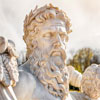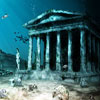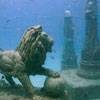Atlantean History – Part IV
 By Yolen, Scribe of Atlantis
By Yolen, Scribe of Atlantis
Notes on Atlantean History during the Reign of Emperor Atlas:
The evil influences pervading the empire, brought to this peak by the Priests of Bel-Ra, have changed the once-harmonious conditions of Atlantis to one of unrest, fear and trouble. Hitherto happy homes are disrupted because one parent or the other, or, perhaps another member of the family is a loyal Templar, while the others have fallen victims to Idolarty. Children of Templars come of age when they are free to choose their way in life, and they marry into families that are secretly allied in the worship of Bel-Ra. In the families of the most faithful Templars there may be one member that secretly follows the teachings of Ritaro, High Priest of Idolatry of Atlantis. Thus it is that estrangements grow apace in homes where all should be unity and harmony. Such estrangements bring antagonism and strife in our midst.
Since Idolatry, which began with the reign of Dionysos and has reached its zenith during the last decade, the high standard of chastity and honor always maintained by Atlanteans has fallen lower and lower. At the present time the people in general accept a state of sensuousness as inevitable. Some hope this will change and sex conditions be improved; some fear matters will become increasingly worse until the final scene is due upon the stage of the world.
The forces of Nature keep corresponding action with the confusion so general in Atlantis. The subterranean fires, which have been banked for ages past, are breaking forth again. In the Far West and the North Mountain ranges, where Idolatry flourishes most of the volcanic disturbances and earthquakes are much more disastrous than in the South Provinces and upon the Continent Isle—our own province of Paradise.
It is noticeable also, that since the beginning of the reign of Atlas, at which time Ritaro boldly came to the Capital City to live and establish his religion of Bel-Ra, the Continent Isle of Atlantis has experienced quakes and eruptions of volcanic peaks, once deemed burnt out and dead, in her mountains. During the last five years, with the entire land overrun by paganism—as a jar of molasses is swarmed by ants—the menace of volcanic eruptions and earthquakes is constant and increasingly severe.
In the Law of One we are taught that Nature, in her way, resists antagonistic vibrations that come from the chemicalization of the mortal opposition to the Light. This miasmi of evil and sensuous thinking and living grows worse, hence conditions keep pace with them.
Wars, riots, fire and floods cause havoc in every section of the world; and in the Continent Isle of Atlantis such awful explosions from the depths of the earth have torn asunder the mountains whence come our solar heat and refrigerated air, as well as water supply, that disaster and loss has followed in their wake. Repeatedly the supplies of water, heat and cold have had to be shut off for repairs to the great piping systems that run into the towns and cities. Yet the people continue in their hypnotic state of sleep—that is their minds are dulled even while their bodies move about—without thought of danger.
The Templars work valiantly to overcome such conditions, but Idolatry has so lulled to stupefaction the wits of its dupes that they cannot wake up to ward off the oncoming doom of the empire. The Sages and Seers understand perfectly how a race consciousness, such as the Sorcerers have established, will accumulate in its evil power and force until a final upheaval of the atoms of the earth, which have been thoroughly disintegrated by the contrary vibrations of the “work of darkness,” that is so opposed to the Rays of Light, clears the cosmos of its menace to the Law of One.
The marriage of Prince Atlas to Lady Zora, in the City of Zuni proved an event of great encouragement to the Idolators. Under the leadership of Ritaro, they openly took possession of many States and Territories in the name of Bel-Ra. But the dread disturbances of Nature grew worse; and finally the primitive and half-savage Mountain Men of the far-off ranges, scarcely populated by civilized people, left their peaks to seek refuge in the towns and cities. They fell victims to Idolatry and found an outlet in this fiendish worship of their fear and disquietude, which possessed them after leaving their accustomed environment, and the high altitudes in which they had always lived.
The savagery and brutality of the Mountain Men will go down in history as being the most frightful experience Atlantis ever had. The sensuous influences of Sorcery, such as was practiced by the Priests of Bel-Ra, drove the unbridled children of Nature half wild with lust. They soon became unmanageable and went roving far and wide, raping, burning, stealing and murdering all they met, regardless of race, age, sex or faith. It was this horrible state of affairs that made it expedient for the Templars of Atlantis to form an army and enlist the efforts of all that would to subdue and overpower the Mountain Men. The Idolators took no hand in restoring peace and protection in the empire, yet they were directly responsible of the uprising of the half-animal-like men.
It was the first time in the 80,000 years of life in the empire of Atlantis that the Templars had to use force of weapons to compel obedience and safety in the land. It was the first time in the ages that it became compulsory to capture and control the Wild Men of the Mountains. Having captured them it now followed that great buildings to hold them were needed. And it required a large army to keep guard over them, to prevent their escape and a return to their raids. Even so there were many that did escape capture and some managed to gain freedom after imprisonment, by bribing their jailers, who were Idolators masquerading as Templars.
In spite of the increase of Idolatry constantly, the Templars continued heroically against all odds to govern as of yore by the Law of One. The Visions and Voices communicating with the Sages and Seers of the Government Circles continued to be broadcasted over the empire. But the number of followers of the Light grew ever less and less; while the pleasures and prosperity of the Idolators attracted more and more of the people. Moreover the condition in Nature (quakes and volcanic eruptions) became greater and greater in its menace and disastrous results.
Though Atlas and his family were Templars in name, it was well known that some powerful secret influence was at work in the palace—right in the imperial family—that was brought to bear on the Emperor, to secure favorable results for the Idolators. Thus far all the investigations of the Government have failed to discover the cause of such secret power, or the one who used it.
The ancient and costly Temples erected to the glory of and for communication with the Law of One gradually lost their vast congregations. One by one these magnificent and valuable edifices fell into the hands and ownership of the Priests of Bel-Ra. Now the time has come when Temples owned and used by the Templars are in the great minority; and these Temples, once the pride and honor of the Atlanteans, are defiled by the pagans, ruthlessly robbed of their precious relics, and polluted by all the flagrant licentiousness of the Priests.
Correspondingly as Idolatry increased throughout the empire it was noticeable that the fine arts and sciences diminished in popularity. The more victims the pagan god Bel-Ra caught int the toils of Sorcery, the more poverty, sin, disease and death spread throughout the land. The less the Law of One held dominion in the Light of the Inner Shrine in individual consciousness, the greater the fears and unrest of the backsliders. Finally we have reached a time when visitors and business officials, government representatives and strangers to enter our universities fear to visit Atlantis, lest they become embroiled in its seething conditions. Hence they seek that which they desire in other lands and in other cities.
The dire conditions thus brought about: the loss in exports, the diminishing of commerce, the waning prestige to the outside world, caused the Templars to try one last and mighty plea with the Idolators. A great convocation was held at the Temple of Neptune, the Government Hall for such conferences, to seek advice and admonition form Qoka, the ancient Master still in touch with his country’s needs and welfare.
The important convention was attended by all that could gain admission to the Temple—Idolators as well as Templars, and the indifferent, too, were there to influence if possible the Sages and Seers of the Government. But all plans and preparations were set aside by having Qoka, the great Master in the spiritual realms, appear immediately after the opening of the council, and in terms, most severe, prophesy all that will come to Atlantis unless the people turn from their evil ways and sought again the peace and protection of the Light.
Qoka admonished the Templars to continue the public communion in the Temples daily as of yore, and not close the Circles as had been suggested. Without the open Circles for meditation all would be lost. In order to protect and save those who still had faith in the Law of One and would follow the Light, there must be places for worship, and Circles, that the Visions and Voices might communicate to such faithful.
Since that convocation almost seven years have passed by. In this time the constant struggle for supremacy between the Templars and the Idolators has waxed furious. Only recently has one gleam of light encouraged the persecuted faithful in the Law of One—the election of Yolen, the Chief Scribe for the History of Atlantis, from the reign of Atlas to the accession to the throne of Prince Atlan, the next in line.
This chosen Scribe is the son of Ajuna, the greatest Seer in the Government Circle of Sages and Seers. It is to Ajuna that Qoka appears and speaks for the benefit of the People. Seer Ajuna is a descendant of the ancient House of Swoyrian, one of the greatest and noblest families in Atlantean history. Because of Yolen’s residence in the City of Paradise, and his understanding and ability to write fluently in every language spoken in the world, the office as Chief Scribe is very appropriate. But it caused a great disturbance in the circles of Idolatry and a corresponding thanksgiving in the hearts of the Templars, to have so loyal a Templar elected to the position.
It is the secret hope and constant prayer of the Templars that now the days of the pagan are numbered. With the astonishing result of having one of their own people elected to fill so significant a post, it is said the tide has turned at last! Perhaps the City of Paradise, that coveted jewel in the precious crown of the empire, will throw off the yoke of the pagan and come forth resplendent in the Light.
This ancient City has stood supreme over the world during all the cataclysms and upheavals that destroyed other portions of the earth. For the past 200,000 years it has been the Capital of the famous white race of man. The dark-skinned race in ages past was considered little above the highest animal plane. Gradually, however, the two races began to intermingle until changes of color showed in the skins of their descendants, and changes in manner and mind accompanied these new tones of color. Today there are as many colored citizens in Atlantis as there are pure whites. This may account for the growth of Idolatry.
The City of Paradise
All vessels entering the Gulf of Neptune must anchor in the outer harbor first. An enormous mole extends out from each side of the land and forms a vast haven for shipping. The outer bay is called the Outside Harbor. Within this large semicircular haven is the Inside Harbor—the carefully protected place where important vessels are anchored. This harbor is formed by another pair of arms that reach out in the Outside Harbor and permit only vessels having Government certificates to enter there.
Deeply impressive and astounding is the first glimpse of the City of Paradise to a stranger entering the Harbor upon a vessel. It is the most gorgeous, the most amazing, the most perfect city ever planned or built in the world. Besides all this, it is the most ancient spot on earth—a place that has withstood all elements and disasters, such as have changed the geography of the lands again and again.
From a distance out on the Gulf the sky line of the city is picturesque in the extreme. Drawing nearer, the stranger upon the deck of the vessel sees a blending of dazzling domes of the Temples of the Law of One; turrets of the edifices used by the Idolators; gleaming tiles roofing the public buildings; beautiful groves of rare tree. The finest and most famous of groves being that one surrounding the Temple of Commerce, and the Guest House, immediately facing the water front of the Gulf of Neptune. This grove has the ancient Sequoias of thousands of years ago still growing and spreading their gigantic branches over the people and buildings beneath them.
The first great structure of note to appeal to the gaze of the stranger coming within our gates is the ancient Temple of Neptune, perched like a mighty eagle upon the highest crag of the semicircular coast line of the Bay, brooding over its young under its widespread wings. It was from this famous Temple that civilization received its wisdom, its sciences, and the success that resulted from obedience to the Visions and Voices given in the Light, while communing in the Law of One in the sacred precincts.
The Temple of Neptune, topping the great Rock of Neptune, looks insurmountable from the Harbor, so precipitous is the side facing the water. From the land sided, however, there are three broad avenues of approach, of gleaming white marble. Great wide flights of stairs and terraces make the avenues a place in which to loiter and enjoy the extensive views of city and sea. The Temple is built of great blocks of marble, not a seam or joint showing in its ancient surface. The vast dome is of dazzling gold, which has been used over the original copper roofing during the reign of Dionysos.
Visitors to the City of Paradise say that three things are most in evidence: scientific construction, rare and beautiful materials used, and the perfect art, symmetry and practicability of architecture and buildings. It is a truth that Atlanteans do not stint when the cost buildings is a question of sacrifice to art and beauty.
After passing the quarantine and other inspection officials, the vessel bearing the visitor enters the Inner Harbor and is docked at her pier. The first thing one admires after leaving the boat is the marble terrraced water front. This lovely strip of park-like land borders the entire half-circle of the Bay. Not only shrubs and flowers, but shade trees and arbors add to the beauty of the terrace. Marble seats and tables provide practical bits of art, while the post chutes and arc lights cunningly placed in convenient locations, all tend to enhance the attractiveness of the water front.
An official guide meets the visitor, and conducts him to the next point of interest—the immense Temple of Commerce. Here all matters of business are transacted in connection with imports and exports. So vast is this building that it seems impossible to use the large chambers and vaults; but the guide assures one that not a spare inch of room is to be found, since commercial transactions in Atlantis are so enormous and many.
The lovely Grove of Neptune, previously spoken of, surrounds the Temple of Commerce. In the Grove, at each side of the Temple are elaborate entrances to the subway which runs underground from the water front to the great Mart which is located in a valley back of the City. More of this Mart anon. Through this tunnel passes all freight and other matter which has been brought in on ships, or is to be sent out to all parts of the world. On the right side of the Grove stands the mighty Rock of Neptune, crowned by its famous Temple. On the left side of the Grove is the beautiful Temple of Literature. These three public buildings, the first to be visited by a stranger, so impress him that the way is prepared for more magnificent edifices later on.
Excerpt from The Prince of Atlantis by Lillian Elizabeth Roy
For the other parts to this series, see here.
Posted in Atlantean History, Atlantis, True History of Manwith comments disabled.





